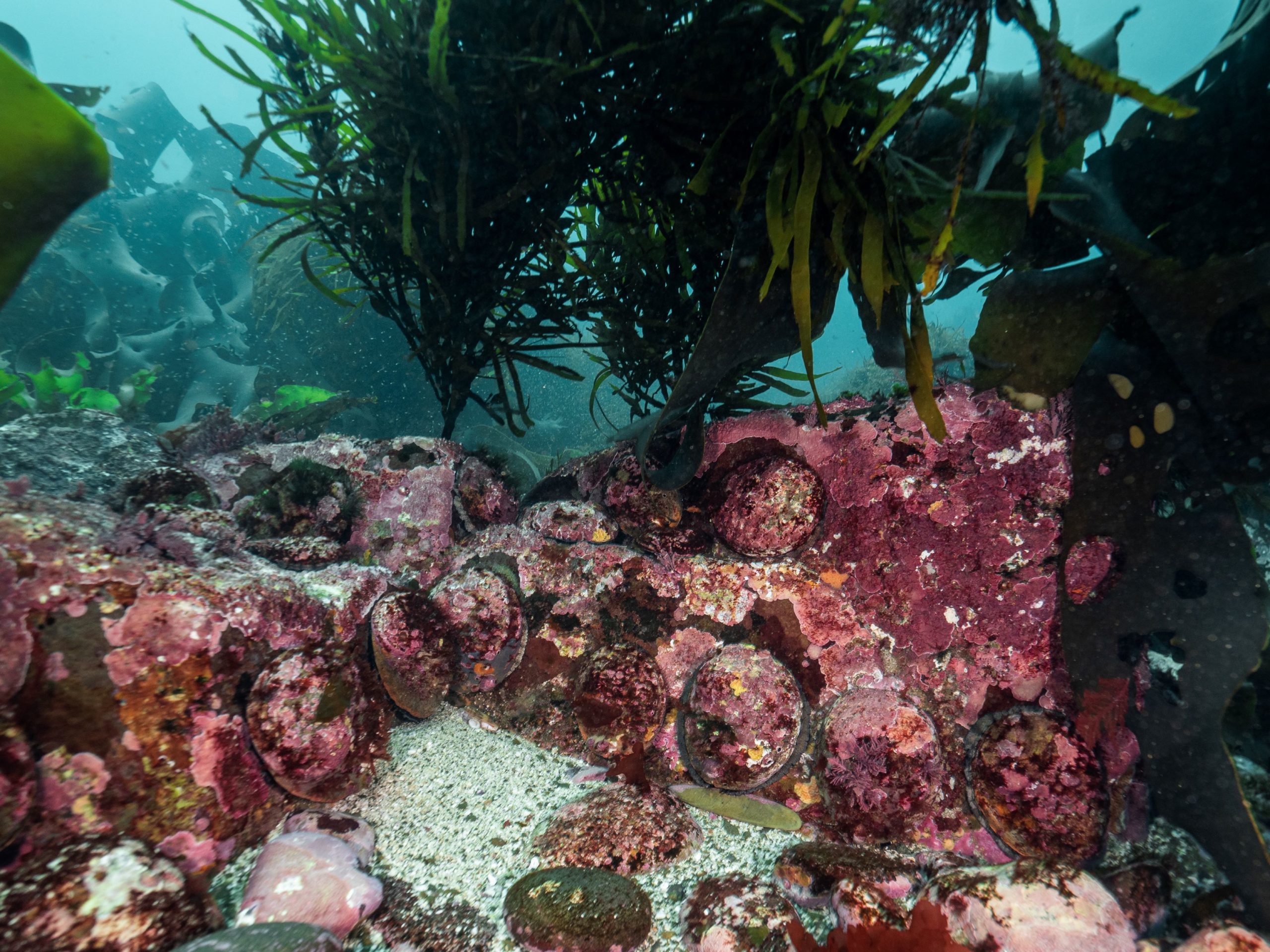Ecosystem and Habitat Interactions

Credit: Matt Testoni
Climate Change Related Effects
There have been clear changes in subtidal reef habitats on the East coast of Tasmania over the past four decades, with the southward retreat of Macrocystis pyrifira beds and the southward expansion of Centrostephanus rodgersii two easily observed examples. The majority of destructive grazing by C. rodgersii is deeper than the typical depth range exploited by abalone fishers (Johnson et al., 2011), but there are localised direct impacts on abalone populations in sheltered reef systems north of Maria Island. Destructive grazing of C. rodgersii in the Kent Group (north of Flinders Island) has been tracked over the past 30 years, and pre-dated the expansion of this species on the mainland coast of Tasmania (Johnson et al., 2005).
The frequency and intensity of Marine Heat Waves (MHW) has recently been documented for Tasmania’s east coast (Oliver et al., 2017b). The East coast has experienced several minor and two major marine heat wave events over the past two decades (2009/2010 and 2015/2016). These MHW’s to result in low level mortality of wild abalone in late summer, over most of the Tasmanian East coast (Bicheno south to the Actaeon region), although the magnitude of the extent of the MHWs on exploitable biomass remains unquantified. No mortalities were observed on the West or North coasts. There is possibly a third minor and localised event in the summer of 2000/2001, although no reports of mortalities of wild abalone were recorded from that period. There is no research and no understanding as to whether these changes have also affected coastal productivity in a way that might effect abalone population dynamics. In contrast to the East Coast, there are no reports from abalone fishers of dramatic ecosystem changes on the north, south or west coasts or from King and Flinders Islands.
Effects of Removal of Abalone on Habitat
Associated with harvesting of abalone stocks, there have been persistent reports from divers of changes to reef habitat. These changes appeared to follow extensive depletion of abalone populations by fishing, suggesting a level of interdependency between abalone and habitat. Perceived changes include a reduction in coverage of crustose coralline algae and its subsequent replacement by sediment, other encrusting organisms and algae, and potential flow on effects to juvenile abalone recruitment (McShane and Smith, 1991; Shepherd and Turner, 1985). Globally, over-harvesting of herbivores is recognised as one of the main factors contributing to changes in marine systems (Burkepile and Hay, 2006). However, it appears unlikely that this broad concept applies to abalone fisheries. A review of ecological impacts of fishing found little evidence of ecological impacts of harvesting abalone (Jenkins, 2004), and concluded that abalone harvesting was relatively ’benign’. Afield study exploring links between abalone abundance, fishing pressure and key habitat characteristics Valentine et al. (2010) found little evidence to support the assertion or perception that removal of abalone from subtidal reefs leads to environmental change. Manipulation of abalone densities also found little evidence to suggest direct effects of abalone on local benthic communities (Strain and Johnson, 2010), other than on encrusted red algae (ERA) (Strain and Johnson, 2012). An investigation of the degree of association between abalone and ERA (Hildenbrandia spp and Peysonellia spp) found that abalone were more frequently associated with these species than expected by chance, but it was not clear whether these species recruit to the substrate beneath abalone home-sites, or whether abalone choose home-sites where there these species are present (Valentine and Mundy unpublished data).
Since the mid 1980’s Tasmanian abalone fishing vessels have fished live (i.e. not anchored), such that anchor damage is negligible in this fishery.
By-catch and Other Species Interactions
There is no bycatch associated with this fishery. All abalone are hand-harvested by divers operating on low pressure surface supply (hookah). The small vessel size used by most abalone fishers, and the shallow water and proximity to the exposed coast also limits negative impacts on other mobile fauna.
A poorly understood aspect of abalone fishing on ecosystems is whether there is a potential for a competitive release effect on other coexisting grazing species. Anecdotal information from abalone fishers in other states suggests significant depletion of abalone populations allows more rapid expansion and dominance by the long-spined sea urchin Centrostephanus rodgersii. Experimental manipulations of interactions between H. rubra and C. rodgersii are not conclusive (Strain and Johnson, 2009), and limited by the artificial environment in which the experiments were conducted.
Trophic Effects
There are few significant predators of emergent Haliotis rubra in Tasmania, and most predation events are opportunistic or target weakened individuals. Reduced grazing pressure by removal of significant biomass of this macro-invertebrate grazer is unlikely to lead to habitat change (Valentine et al., 2010), as there is an oversupply of kelps across the fishery, which is subject to seasonal storms generating drift algae. Much of the food consumed by abalone is likely to be drift algae rather than attached growing plants.



